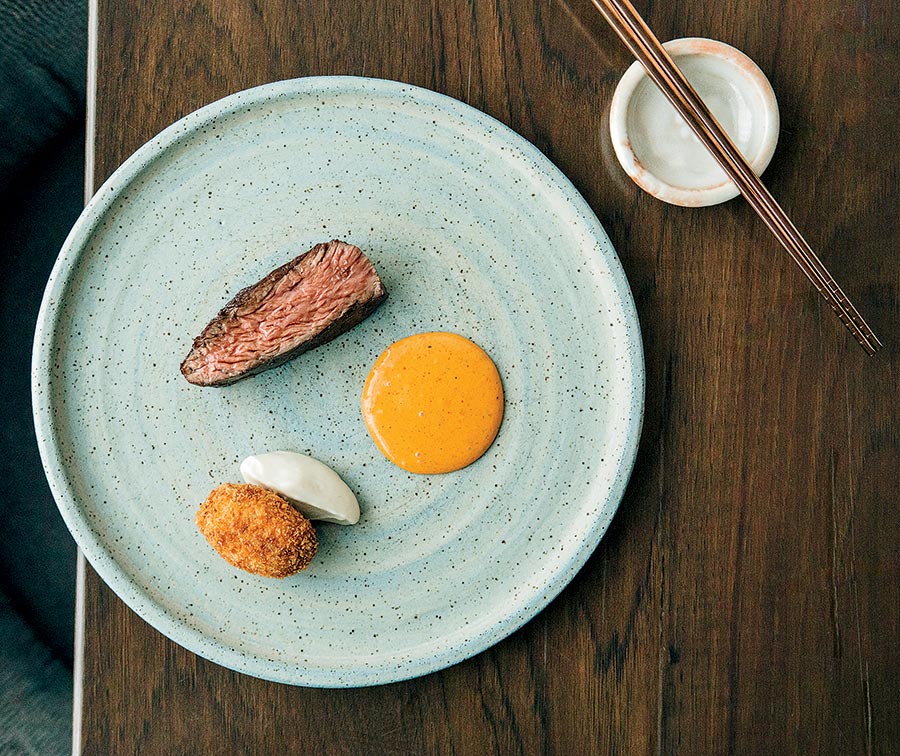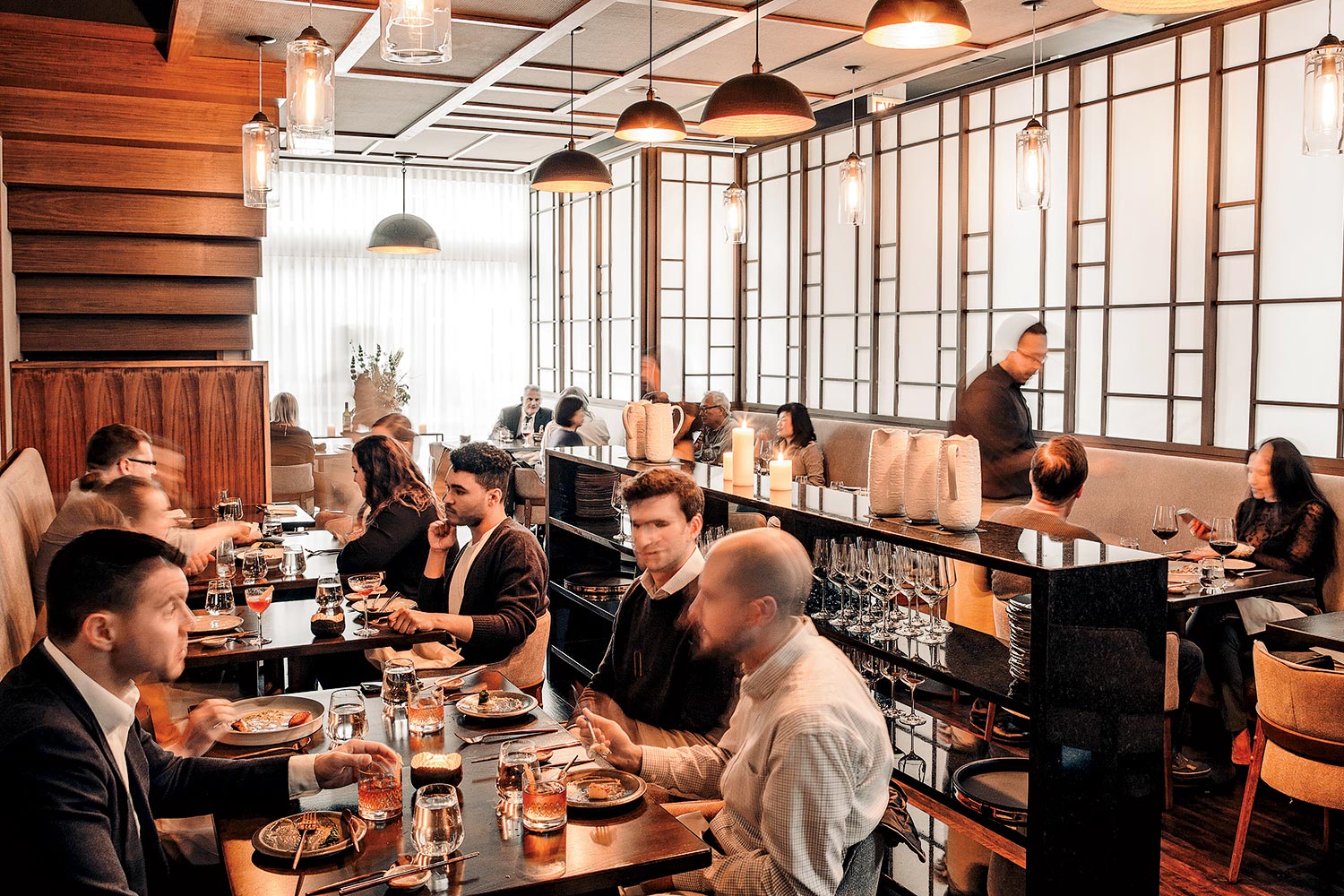My relationship with tasting menus is a long and winding road, littered with lusty declarations and unmet expectations. As a young writer, I considered myself an aesthete (though I wasn’t sure how to pronounce the word), and I saw the tasting menu as the pinnacle of food as art, a sanctioned bacchanal for ambitious gluttons. I recall a five-hour feast during Grant Achatz’s earliest days at Trio that lasted until 1 a.m. There were at least 15 moments that bowled me over, and the whole thing left me in a glorious food coma for 24 hours.
But as I aged, the excess became less exciting. And so did the menus. Suddenly chefs had free rein to serve bloated processions that had two or three interesting ideas surrounded by 13 senseless ones. Add wine pairings and you got a barrage of filled-to-the-rim glasses that, unless you had the tolerance of a rugby team, were impossible to finish, let alone enjoy. So to the à la carte menu I returned, content with simple meals done well, and it seems as if most of the city followed suit. (Think of how many tasting-menu-only spots have closed in Chicago in the past few years: Tru, L2O, and Sixteen, to name a few.) And yet I still found myself wondering if I was missing the real action.
So I took the plunge again at Jeong, a new Korean spot that catches chef Dave Park on the verge of megastardom. He made the prix fixe menu short and affordable (seven courses, $87), partially to avoid overlap with the restaurant’s more down-to-earth à la carte menu. But he clearly shares my tasting menu fatigue.
Perhaps you remember Park. In 2017, the South Korean native and his fiancée, Jennifer Tran, were running Hanbun, a Korean fast-food kiosk in the food court of a suburban mini mall, and serving after-hours BYOB tasting menus in the tiny kitchen at a single table. I was impressed by the food and charmed by the couple, both 27 at the time and attendees of the Culinary Institute of America.
Jeong (pronounced chung) represents a major step up in setting. Park and Tran, the restaurant’s general manager, redid the space themselves, integrating clever personal design elements such as dangling light fixtures inspired by traditional Korean bronze bowls. The overall vibe is simple and sleek, cannily erasing the line between casual and upscale.
And from the first course of the tasting menu, I knew that Park had also taken his food to the next level. In that dish, thick, succulent coins of king crab nestle with twigs of pickled ginger, chile-braised fern, and a marmalade of maesil (Korean plums), its assertive flavors leaping off a base of mild silken tofu. The next offering, a puck of salmon tartare, was Park’s inspired take on hwe (pronounced way, as in “way better than sashimi”). Instead of serving the fish with vinegary gochujang sauce, he gives it a whisper of yuzu and doenjang, a fermented soybean paste that reminds him of the stuff his grandparents kept in their kitchen. The dish’s texture was a journey unto itself, from the supple salmon to lush dabs of crème fraîche offset by bubu arare (cracker-like toasted rice orbs). It’s my favorite thing from 2019 so far. Not my favorite dish. My favorite anything.

Less showy but equally memorable was the sweet seared scallop balanced by an intricate roll of namul, a typical banchan, or side dish. Park gently sweats garlic, ginger, and shallots in sesame oil and dresses greens in the brew, then lines them up with the scallop across a golden pond of clementine beurre blanc — basically, creamed spinach with a well-worn passport.
Jeong’s next two courses were stone-cold masterpieces. First was a microcosm of the bapsang (the traditional Korean set table, with a main dish, rice, and an assortment of banchan): slices of seared duck ladled with a thick tea-soy glaze; nutty Chinese pearl barley, short-grain rice, and corn tea that smelled like popcorn; and a deep-flavored kimchi. The beautiful triptych feels modern but preserves the spirit of Korean cooking, and it serves as Jeong’s mission statement without being all obvious about it.
Then came a dish six years in the making. In 2013, Park ate a snack in Korea so good that it haunted him. After playing around with his own version for years, he finally unleashed his sunchoke croquette, a crisp beauty whose earthy tones make the ideal foil for a medium-rare bavette of American wagyu with a powerful kimchi-truffle emulsion. It looks minimalist, but that belies how much work went into it.
A baseball superstition holds that if a pitcher has a no-hitter going, you don’t mention it, lest you jinx it. This is true of great meals, too; my wife and I ate the last two courses at Jeong in a hopeful silence. The ritual worked: first the bokbunja, a buttery disc of ginger shortbread with a punchy Korean black raspberry and wine granita in the center and a ginger tea crema lurking beneath, and then the final course, a dense chestnut financier. Inspired by chestnuts roasting in the winter, it’s slyly sandwiched between layers of caramel made with doenjang and smoked chestnut cream and flanked by whipped chocolate ganache. A dramatic upgrade to the financier he did at Hanbun, it captures everything about where Park is right now: at once nostalgic and inventive, and constantly refining.
Even the five modestly priced (and poured) wine pairings get it right. Instead of anesthetizing the taste buds, the unpredictable picks — such as a marmaladey 2016 Foxen Block UU Chardonnay Bien Nacido from California’s Central Coast — dovetail beautifully with the extraordinary flavors on display.
If I come across as a fanboy, so be it. It’s exciting to watch as a talented chef steps into the spotlight and absolutely kills it. Park gives us his artist’s statement, free of excess and exclamation points. And rather than pummeling diners with strenuous wizardry way past their bedtime, he gets the point across in two hours. I’m in love again.



